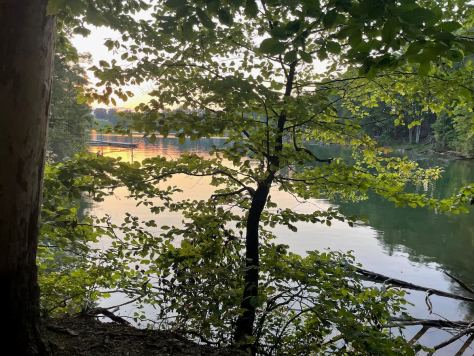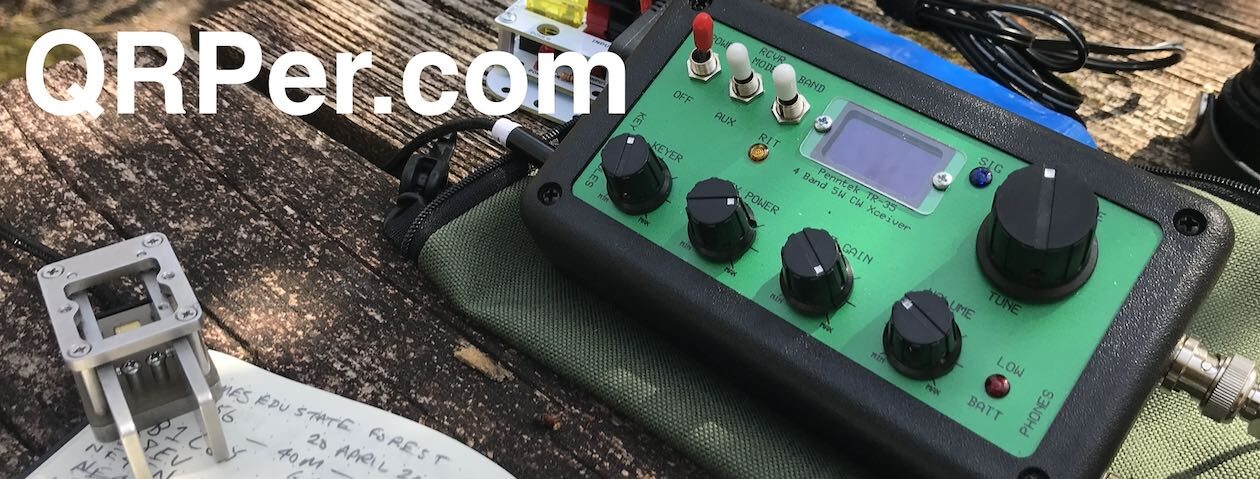On Sunday, August 20, 2023, en route to check in with my parents, I popped by Lake James State Park for a little early evening POTA fun.
In the car, I’d pack the Elecraft KX2 kit and I still had the REZ Ranger 80 vertical antenna system on loan from REZ Antennas (it’s since been returned to them).
 The last time I deployed the REZ was on Mount Mitchell in some pretty sketchy weather. While I recorded a couple of short videos, I didn’t record a full activation video since we were having a family picnic that day.
The last time I deployed the REZ was on Mount Mitchell in some pretty sketchy weather. While I recorded a couple of short videos, I didn’t record a full activation video since we were having a family picnic that day.
Before sending the Ranger 80 back, I wanted to fit in a proper activation showing how I deploy the antenna, how I tuned it for the first time, and how it might perform on the 40 meter band.
Lake James State Park (K-2739)
It was golden hour at Lake James and the park was bustling with activity. There were kids running around, parents chasing them, and several families cooking out at the numerous picnic sites.
I sought out a location that was private and quiet mainly because the Ranger 80 antenna has four 31 foot radials, thus a large footprint; I didn’t want children, pets, or anyone tripping on the ground radials.
Fortunately, one of my favorite spots overlooking the lake was free, so I could simply set the Ranger 80 up in the woods where folks weren’t walking.
The Ranger 80 is super easy to deploy: simply extend the vertical, attach it to the top of the base, then attach the stainless spike to the base and plunge the entire thing into the ground. Next, you deploy the four radials and connect it to the base of the antenna.
It only takes a couple of minutes especially since the counterpoises are wound using the over-under method. I simply tossed each line into the woods and didn’t worry if they were all lying perfectly on the ground.
Note to REZ: Consider offering optional high-visibility counterpoise wires–for those of us setting up in busy parks, it would make the ground radials more conspicuous to passersby.
Next, I needed to tune the Ranger 80 for the forty meter band.
Typically, when I use a sliding-tap tuning coil style antenna like this one, I turn on the radio and move the coil until I hear an audio peak, then I fine tune it by sending a “dit” on the radio, checking the SWR, and adjusting the coil slider.
That evening, though, I had my RigExpert AA-35 Zoom antenna analyzer so I set it to continuous SWR monitoring and adjusted the coil until I achieved a good match. Easy.
I should add here that when you use an antenna like this frequently, you learn where the best tap points are on the coil thus tuning becomes easier. My friend Alan (W2AEW) actually made a PVC rig for his coil antenna (click here to check it out).
 With the antenna all set up and ready to rock-and-roll, I simply hooked up the Elecraft KX2, my VK3IL pressure paddles, and prepared the logs.
With the antenna all set up and ready to rock-and-roll, I simply hooked up the Elecraft KX2, my VK3IL pressure paddles, and prepared the logs.
It was time to play radio!
Gear:
Note: All Amazon, CW Morse, ABR, Chelegance, eBay, and Radioddity links are affiliate links that support QRPer.com at no cost to you.
- Elecraft KX2
- Elecraft KXBT2 Li-Ion Battery Pack
- REZ Ranger 80
- RigExpert AA-35 Zoom
- High Visibility Jacket ABR240-UF with PL-259s and 5 Ferrites (Use Coupon Code ABR10QRPER for 10% Discount!)
- VK3IL Pressure Paddle V2
- GraphGear 0.9mm 1000 Automatic Drafting Pencil
- Rite In The Rain Top Spiral Notebook
- Camera: original OSMO Action Camera (the OSMO 3 is the current version) with Sensyne Phone Tripod
On The Air
 I hopped on the air not knowing in what shape 40 meters might be.
I hopped on the air not knowing in what shape 40 meters might be.
Keep in mind that while the Ranger 80 has a great impedance match and a respectable radial system, it’s still a compact vertical for the 40 meter band. I was curious how well it might perform.
 Fortunately, the Ranger 80 (and propagation) did not disappoint!
Fortunately, the Ranger 80 (and propagation) did not disappoint!
I started calling CQ POTA and, once spotted, I was greeted by a small pileup. I logged my first ten hunters in eight minutes. Validating a park in 8 minutes (in CW) is about as good as it gets without running contest speeds and short exchanges (which I never do in POTA or SOTA).
 I continued working 40 meters and there seemed to be no end to the hunters on the bands despite it being the dinner hour in the eastern half of the US.
I continued working 40 meters and there seemed to be no end to the hunters on the bands despite it being the dinner hour in the eastern half of the US.
In the end, I ran out of time having logged a total of 30 hunters in 30 minutes!
What fun!
QSO Map
Here’s what this five watt activation looked like when plotted out on a QSO Map:
Activation Video
Here’s my real-time, real-life video of the entire activation. As with all of my videos, I don’t edit out any parts of the on-air activation time. In addition, I have monetization turned off on YouTube, although that doesn’t stop them from inserting ads before and after my videos.
Note that Patreon supporters can watch and even download this video 100% ad-free through Vimeo on my Patreon page:
Click here to view on YouTube.
Ranger 80 Recap
If you’re looking for a portable high-quality, tunable, vertical antenna that can handle 500 watts SSB or 250 watts CW/Digital Modes, the Ranger 80 should be on your radar.
For the QRPer? Frankly, it’s a bit of overkill if you didn’t gather that from my activation video. It works very well, but being a QRPer and portable op guy, it’s just too heavy and over-engineered for what I do. Also, I’m personally not a fan of sliding tuning coil antennas–this is why I recently sold my Wolf River Coils TIA at the Shelby hamfest.
That said, I have POTA friends that absolutely swear by tuning coil antennas like the REZ and WRC because they are so portable, reliable, can be matched to any radio without the need of an ATU, and, frankly, they’re effective for POTA and SOTA. Indeed, I know a couple of avid POTA activators that only use tuning coil verticals.
In truth, they’ve a lot going for them.
At the end of the day, the antenna you love has everything do to with your own preferences as an operator.
If I were packing a QRO rig, the Ranger 80 would be very tempting. At $550 US, it’s certainly a “buy once, cry once” antenna. I’m a fan of high-quality products and enjoy supporting manufacturers making their products domestically even if that comes at a premium.
The Ranger 80 is the sort of antenna you’ll likely leave in your will and pass on to the next generation! Hard for me to believe it’d ever fail you.
Many thanks to Mike at REZ for letting me take the Ranger 80 to the field!
Thank you!
 Thank you for joining me on this most enjoyable activation!
Thank you for joining me on this most enjoyable activation!
I hope you enjoyed the field report and my activation video as much as I enjoyed creating them.
 Of course, I’d also like to send a special thanks to those of you who have been supporting the site and channel through Patreon and the Coffee Fund. While certainly not a requirement as my content will always be free, I really appreciate the support.
Of course, I’d also like to send a special thanks to those of you who have been supporting the site and channel through Patreon and the Coffee Fund. While certainly not a requirement as my content will always be free, I really appreciate the support.
As I mentioned before, the Patreon platform connected to Vimeo make it possible for me to share videos that are not only 100% ad-free, but also downloadable for offline viewing. The Vimeo account also serves as a third backup for my video files.
 Thanks for spending part of your day with me! Have an amazing week ahead!
Thanks for spending part of your day with me! Have an amazing week ahead!
Cheers & 72,
Thomas (K4SWL)












Looks like a great antenna. I have the WRC which works really good when you have no trees to use. A lot of my Parks here in MO are Conservation land which are parking lots looking out into prairie grass so the WRC comes in handy. Of course I would much rather throw a wire up in a tree. I always carry my throw rope and wire in my backpack.
Nice report. Thank you for including a link to my adjustment gauge – hopefully the concept will help others with this, or similar antennas. Extra nice that I made it into your log! You’re right, that doesn’t happen often enough!
…also extra nice that I worked you from the vacation house using the TR-45L.
I’m sorry but I just cannot believe the prices of these antenna systems these days. I had a Super Antenna back in the day. It was based loosely on the W6MMA coil used for the St. Louis vertical. You can make an effective version of the bases loaded vertical for about $30. It ain’t pretty but I have been using this antenna version for about 25 years. You use a 20 foot crappie pole, stainless wire and pipe insulation foam. I can provide details if interested. Works 160-10 depending on the coil length and vertical wire length. Telescopes down to about 3-3.5 foot length. Very light. And you can use it to raise a wire antenna as well. I used it inverted L style with a longer wire vertical sloping from the top to the ground for 160 and also had the coil inline. Very interesting to play with and what Hams like best, cheap!
Jess AE0CW
An excellent build quality antenna thats an investment
I have made excellent contacts on the lower bands and have proven it to be better than short 4 foot whips and hamsticks
No add on coils for 80 or 60m
Tripod makes a solid deployment on sidewalks and parking spots
John ve3ips